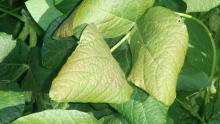Information Possibly Outdated
The information presented on this page was originally released on July 19, 2012. It may not be outdated, but please search our site for more current information. If you plan to quote or reference this information in a publication, please check with the Extension specialist or author before proceeding.
Researchers test disease resistance in soybeans
By Dr. Rebekah Ray
MSU Delta Research and Extension Center
STONEVILLE – Mississippi State University scientists are trying to identify soybean varieties resistant to a disease that can reduce yields by more than 20 bushels per acre.
MSU plant pathologist Gabe Sciumbato and research associate Walter Solomon are checking soybean varieties for purple leaf blight through MSU’s soybean variety trials. Both are Mississippi Agricultural and Forestry Experiment Station researchers at MSU’s Delta Research and Extension Center in Stoneville.
“Purple leaf blight has spread across the southern United States during the past several years,” Sciumbato said. “The fungus infects soybeans at different stages, causing purple seed stain, purple leaf blight and pod rot. It can overwinter in plant residue. Soybeans have no known resistance against this disease.”
One of the state’s most serious row crop diseases, purple leaf blight is caused by the Cercospora kikuchii fungus. The blight occurs late in the growing season, especially during severe heat or extremely wet conditions, and causes soybeans to mature from the top down. Symptoms first show in the upper leaves as a general bronzing. Reddish-purple or bronze spots make leaves appear leathery or sunburned.
To test for resistance, Sciumbato and Solomon use repeated field trials to rate the disease’s development. Varieties may be rated completely resistant to the fungus, extremely susceptible to it, or anywhere in between.
“By growing the fungus in our laboratory, we can inoculate plants with different concentrations of the fungus at different growth stages and at optimum environmental conditions for disease development,” Solomon said.
Plants that are resistant to the leaf phase of the disease may not be resistant to the seed or pod stages of the disease.
While timely foliar fungicide applications have reduced yield losses, they have given inconsistent results with purple leaf blight control in soybean, Sciumbato said.
This research is supported in part by grants from the Mississippi Soybean Promotion Board and the U. S. Department of Agriculture.










